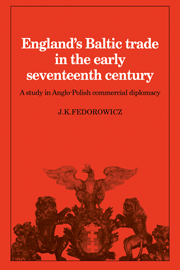 England's Baltic Trade in the Early Seventeenth Century
England's Baltic Trade in the Early Seventeenth Century Book contents
- Frontmatter
- Contents
- Preface
- List of maps and graphs
- List of abbreviations
- Map
- Introduction
- 1 English perceptions of the Polish Commonwealth
- 2 The mechanics of English diplomacy in the Eastland
- 3 The early history of the Eastland Staple at Elbing
- 4 The operation of the staple
- 5 The pattern of English shipping into the Baltic
- 6 English exports to the Baltic
- 7 English imports from the Baltic
- 8 The threat to the Eastland Staple at Elbing
- 9 The depression of 1620 and the crisis of England's Baltic trade
- 10 The political crisis, 1620–9
- 11 The mission of Sir Thomas Roe to the Eastland
- 12 Attempts at reconciliation with Danzig, 1630–5
- 13 The climax of English commercial diplomacy, 1635–42
- 14 Conclusion
- Notes
- Bibliography
- Index
6 - English exports to the Baltic
Published online by Cambridge University Press: 05 November 2011
- Frontmatter
- Contents
- Preface
- List of maps and graphs
- List of abbreviations
- Map
- Introduction
- 1 English perceptions of the Polish Commonwealth
- 2 The mechanics of English diplomacy in the Eastland
- 3 The early history of the Eastland Staple at Elbing
- 4 The operation of the staple
- 5 The pattern of English shipping into the Baltic
- 6 English exports to the Baltic
- 7 English imports from the Baltic
- 8 The threat to the Eastland Staple at Elbing
- 9 The depression of 1620 and the crisis of England's Baltic trade
- 10 The political crisis, 1620–9
- 11 The mission of Sir Thomas Roe to the Eastland
- 12 Attempts at reconciliation with Danzig, 1630–5
- 13 The climax of English commercial diplomacy, 1635–42
- 14 Conclusion
- Notes
- Bibliography
- Index
Summary
As suggested in the previous chapter, the changing size of English vessels renders a bare presentation of shipping statistics inadequate as a description of changes in the volume of England's Baltic traffic. Only a close analysis of the contents of English vessels will allow for a reconstruction not only of changes in the quantity, but also in the quality of the merchandise being shipped into the Sound.
Once again the STT are the most complete source for such a reconstruction, despite all the difficulties that this source entails: the true ownership of the cargoes is impossible to establish on the basis of the STT as the compilers merely assumed that the nationality of shipmaster, shipowner, cargo owner and cargo were all identical. Certainly the distortions inherent in this assumption are minimized in the case of the English because certain goods, such as Suffolk broadcloths, can only be English in origin. Furthermore, it is unlikely that English ships would have carried any non-English goods as English shipping was less efficient and more expensive than the Dutch fluyt. If one restricts the study to the cargoes of English vessels alone, one may be sure that only English goods are being included. On the other hand, such a study obviously ignores those English goods carried by the Dutch, though this carrying trade was less significant for exports to the Baltic than for the bulky commodity imports from it, where cost and efficiency of shipping was crucial.
It is also important to remember that there was a great reform of Danish customs procedures in 1618 which rendered the recording techniques of the STT more reliable.
- Type
- Chapter
- Information
- England's Baltic Trade in the Early Seventeenth CenturyA Study in Anglo-Polish Commercial Diplomacy, pp. 90 - 101Publisher: Cambridge University PressPrint publication year: 1980
